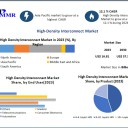
Global High-Density Interconnect Market size was valued at USD 16.81 Bn. in 2023 and the total High-Density Interconnect revenue is expected to grow by 12.1 % from 2024 to 2030, reaching nearly USD 37.39 Bn.
High-Density Interconnect Market: Global Demand Surges as Miniaturization and High-Performance Electronics Reshape PCB TechnologiesThe Global High-Density Interconnect (HDI) Market, valued at USD 16.81 billion in 2023, is on an accelerated growth trajectory. With rapid technology shifts across automotive electronics, consumer devices, and communication systems, the market is expected to expand at a CAGR of 12.1% from 2024 to 2030, ultimately reaching USD 37.39 billion by 2030. HDI represents one of the most advanced branches of printed circuit board (PCB) technology, enabling greater wiring density, enhanced signal integrity, and superior miniaturization.
Understanding the HDI Market
HDI PCBs are engineered to deliver more interconnections per unit area, making them ideal for devices that require compact designs without sacrificing performance. Incorporating features such as microvias, blind and buried vias, high-layer stacking, and improved signal pathways, HDI solutions bridge the gap between traditional PCB limitations and modern requirements for speed, efficiency, and durability.
As industries transition toward compact, lightweight, multi-functional, and high-speed electronics, HDI technology has become indispensable—especially in 3C (computers, communications, consumer electronics), automotive, wearable devices, and medical equipment.
Access your free report sample — uncover the top-performing segments today: https://www.maximizemarketresearch.com/request-sample/26294/" target="_blank"> https://www.maximizemarketresearch.com/request-sample/26294/
Key Growth Drivers and Market Opportunities
Rising Demand for Portable and Multifunctional Devices
Consumer expectations for slimmer, lighter, and more powerful devices continue to escalate. HDI technology enables OEMs to embed more components into smaller spaces, dramatically improving signal transmission speed and reducing layer count while lowering the overall PCB footprint.
Technological Advancements in Automotive Electronics
The modern automobile heavily relies on electronics for ADAS, infotainment, EV battery monitoring, safety systems, sensing technologies, and connectivity. HDI PCBs meet the automotive industry’s stringent requirements for reliability, thermal performance, and durability, making them essential in next-generation vehicles.
Miniaturization: A Core Market Catalyst
Rapid advancements in computing and communication have triggered a push toward device miniaturization across all electronics sectors. HDI PCBs support high-density component placement and finer pitch packaging, enabling faster performance without increasing device size.
Expansion of EMS Partnerships and Outsourced Manufacturing
OEMs increasingly rely on EMS providers to manage complex PCB design, assembly, and testing. This shift reduces production costs and opens significant opportunities for HDI PCB manufacturers to move into JDM (Joint Design Manufacturing) and ODM (Outsourced Design Manufacturing) models.
As cost pressures intensify, strategic alliances between OEMs, PCB manufacturers, and EMS providers will continue to redefine competitive dynamics and unlock new revenue streams.
Segmentation Overview
By Product Type
4–6 Layers HDI
8–10 Layers HDI
10+ Layers HDI
Higher layer counts are increasingly in demand for applications requiring robust multi-functional circuit integrations.
By Application
Automotive Electronics (Fastest-growing segment at 10.7% CAGR)
Computer & Display
Communication Devices & Equipment
Connected Devices
Audiovisual Devices
Wearable Devices
Others
HDI plays a critical role in supporting high-speed data transmission, signal accuracy, and component miniaturization across all these verticals.
By End-User Industry
Automotive
Consumer Electronics
Telecommunications
Medical
Others
Medical applications—such as wearable health monitors and portable diagnostic equipment—are emerging as a promising growth avenue.
Access your free report sample — uncover the top-performing segments today: https://www.maximizemarketresearch.com/request-sample/26294/" target="_blank"> https://www.maximizemarketresearch.com/request-sample/26294/
Regional Insights
Asia Pacific – The Global Leader
The Asia Pacific region, growing at 7.9% CAGR, dominates HDI production thanks to a robust PCB ecosystem led by China, Taiwan, Japan, and South Korea. China alone hosts over 2,500 PCB manufacturing facilities, supported by abundant raw materials, strong consumer electronics demand, and government initiatives such as “Made in China 2025.”
Taiwan is another major hub, home to multiple global PCB giants, while Japan remains a leading innovator in HDI precision manufacturing.
North America
The U.S. focuses primarily on low-volume, high-mix, high-reliability PCBs for aerospace, medical, defense, and industrial applications. Although production has declined compared to Asia, companies like TTM Technologies maintain significant technological capabilities.
Europe
European manufacturers specialize in advanced PCBs for industrial automation, automotive systems, and telecommunications. Strong emphasis on quality standards and technology innovation supports moderate but steady regional growth.
Competitive Landscape
The HDI market is characterized by strong competition and continuous innovation. Key players include:
Unimicron (Taiwan)
Compeq Co. (Taiwan)
Zhen Ding Tech. (Taiwan)
TTM Technologies (USA)
Austria Technologie & Systemtechnik (AT&S) (Austria)
IBIDEN (Japan)
MEIKO ELECTRONICS (Japan)
Fujitsu Interconnect Technologies (Japan)
Samsung Electro-Mechanics (South Korea)
Daeduck GDS, DAP, Korea Circuit (South Korea)
NCAB Group (Sweden)
Sierra Circuits, Multek (USA)
These companies are heavily investing in high-layer HDI capability, microvia drilling, automation, R&D, and strategic collaborations to strengthen their market positions.
Conclusion
The High-Density Interconnect Market is entering a pivotal growth phase driven by the global shift toward compact electronics, connected ecosystems, AI-enabled systems, and advanced automotive technologies. HDI PCBs deliver the essential platform for high-performance, lightweight, and space-efficient designs increasingly demanded across all major electronic applications.
As OEMs intensify their focus on miniaturization, signaling performance, and production cost optimization, HDI technology will remain at the forefront of PCB innovation. With robust opportunities emerging across Asia Pacific, North America, and Europe, the HDI market is set to expand rapidly, fueled by evolving electronics architectures and the world’s growing reliance on smarter, faster, and more integrated devices.






 supriyamaximize
supriyamaximize
 jamesdavis
jamesdavis alicecgibson
alicecgibson Erica111
Erica111